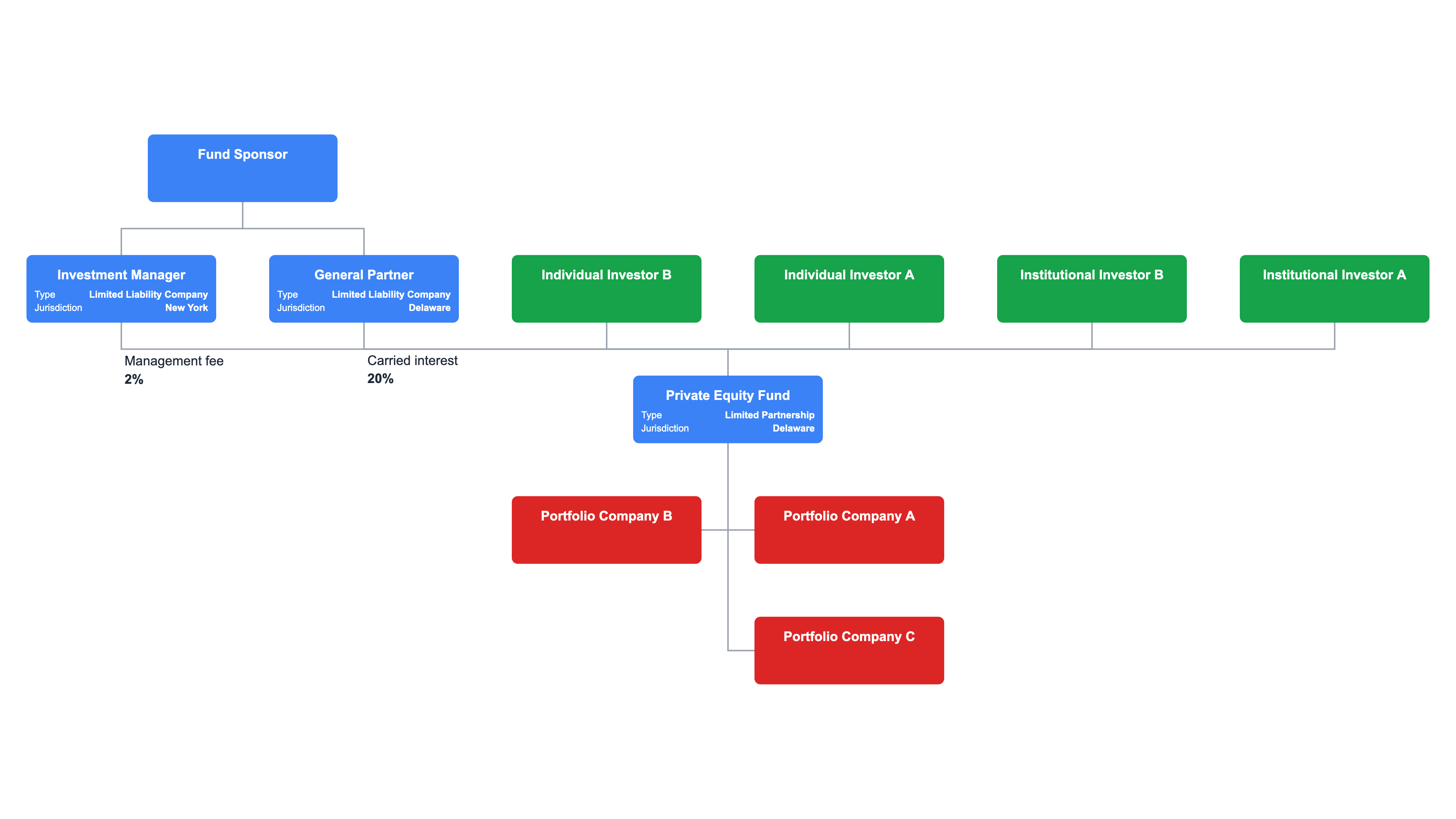Private Equity - Reduce Risk With Better Entity Management
Updated:

Legal entities proliferate for each private equity fund. Private equity funds structured as limited partnerships (LP) in the United States have common characteristics. Entity management software can reduce risk and costs for private equity firms.
Private equity investment structures start with the fund sponsor. The fund sponsor packages and sells investments in private equity funds. A private equity fund might have a thesis or particular investment scope.
The private equity fund sponsor creates the fund organized as a limited partnership. The private equity fund creates the general partner for the LP.
The fund sponsor forms an investment management legal entity to provide investment services to the fund in exchange for a 2% fee.

A private equity fund has three groups of legal entities to manage: the sponsor’s controlled entities, the group of limited partners, and the portfolio companies.
The PE fund sponsor’s controlled entities include:
- the limited partnership fund,
- the general partner which receives the carried interest in LP profits,
- the investment management company which receives a 2% management fee for investment guidance, and
- the fund sponsor itself.
The portfolio companies are related to the fund sponsor. These are all “related” entities, meaning that the fund sponsor actively manages the filings and compliance obligations of each entity.
In contrast, limited partners are “unrelated.” The fund sponsor is not responsible for the compliance obligations of limited partner individuals or businesses.
Read more about the distinction between related and unrelated legal entities.
There are four components to effect entity management for private equity fund companies:
- Document management,
- Compliance monitoring,
- Governance (officers and directors), and
- Ownership.
Document management for PE entities
The demands on document management for private equity firms can be intense and firms have existing solutions in place depending on the internal stakeholder needs.

To oversimplify, Tax has command of tax filings for each entity. Legal has control of inter-company agreements, organization documents, and M&A deal documents. Finance has capital account records.
Entity management affords PE firms an opportunity to provide a single point of document access across teams so Tax, Legal and Finance can collaborate.
At minimum, storing formation documents as part of new fund would include:
- Organization documents for the general partner limited liability company,
- Organization documents for the limited partnership fund, and
- Organization documents for the investment management LLC.
The document repository could include the investment management agreement between the fund manager and the limited partnership.
The documents associated with the fund LP could include the investment agreements and any ensuing capital call documentation for a limited partner.
From the perspective of each portfolio company, the LP will inherit the formation documents as part of the acquisition. The document repository could include the deal documents or at least those needed for more than record retention.
Compliance tracking for PE entities

Legal entity compliance is more than the annual filing. Compliance tracking can include:
- foreign authorizations,
- business licenses,
- industry-specific permits,
- tax obligations,
- DBA or trade name filings, and
- much more
Bringing these compliance obligations into one solution reduces the cost of compliance and legal risk associated with non-compliance.
Governance for PE entities
Private equity firms assign people to multiple governance roles across their legal entities. The same people sit on various boards and/or serve as officers.

Entity management simplifies the assignment and tracking of people in various roles.
Combining that role tracking with governance terms of service allows the private equity firm to analyze who was in charge during any period in the past.
Ownership for PE entities
Private equity ownership structures are complicated. Creating a clear visualization of the ownership structure is time consuming and error prone.

To compound the problem, organization charts are necessary for different purposes, such as:
- internal legal restructuring,
- financing diligence requirements, or
- regulatory filings.
Entity management software should:
- Generate an organization chart automatically,
- Handle any ownership structure regardless of complexity,
- Support charts from the perspective of any subsidiary, not just an ultimate parent, and
- Illustrate the hierarchy of ownership.
Since the ownership information is dynamic, the organization chart should update automatically based on the latest information.
Conclusion
Entity management simplifies compliance, reduces risk, and visualizes organization structure for private equity firms. Software to manage legal entities can be easy-to-use for staff involved in day-to-day operations and cost effective for the firm.